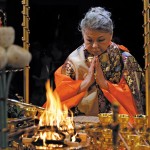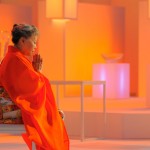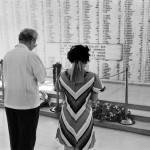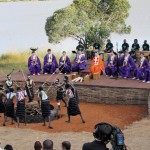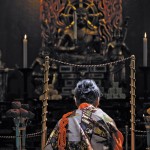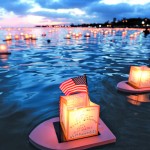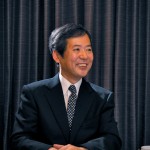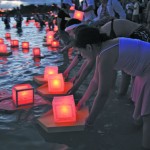Lady of the Lanterns
MidWeek travels to Japan to interview Her Holiness Shinso Ito, who on Memorial Day at Ala Moana Beach Park will officiate her 15th annual Lantern Floating Ceremony
TACHIKAWA, Japan – About to conduct her 15th annual Honolulu Lantern Floating Ceremony on Memorial Day at Ala Moana Beach Park, her image has become so familiar on local newspaper front pages and TV screens (broadcast live since 2007), you might assume she resides in Hawaii. She does not, though she does have a temple here.
- MidWeek travels to Japan to interview Her Holiness Shinso Ito, who on Memorial Day at Ala Moana Beach Park will officiate her 15th annual Lantern Floating Ceremony
- Her Holiness Shinso Ito in prayer | Photo from Shinnyo-en
- Lanterns with remembrances and prayers float at Ala Moana | Photo from Shinnyo-en
Preparing to interview her at the home temple of Shin-nyo-en, the Buddhist lineage her father founded and she now leads, when I mentioned the upcoming trip to friends and associates, everyone seemed to know of her, but almost nothing about her or her faith: Oh, yeah, that floating lantern lady.
As it turns out, almost a year to the day after I shook hands and questioned the Dalai Lama in Honolulu, I was in this western Tokyo suburb to interview Her Holiness Shinso Ito. She is the rare Japanese woman to attain Buddhist “master” status – enlightenment as well as academic accomplishment.
She is a big deal in Japan. Daigo-ji temple in Kyoto, founded in the year 874 and today a Japanese National Treasure and U.N. World Heritage Site, invited her to officiate a ceremony on the anniversary of the founder’s death in the main temple – such an out-of-the-ordinary event it made headlines across Japan. So remarkable, it’s been called “epochal.”
“That they allowed me to do that, they must have surprised the rest of Japanese Buddhist society,” Her Holiness says with a soft laugh.
In a world filled with religious tumult and divide, hers is a voice of calm, reason, inclusion and peace. She always invites religious leaders of other faiths to participate in the Lantern Floating Ceremony at Ala Moana.
It is not about religion, she says. “It is about people.”
Last year she was invited to Kenya, where she officiated a fire ceremony with tribes that traditionally have been at odds, and often at war. Like the Achala Buddha that is revered in Shin-nyo-en Buddhism – he holds a sword in one hand to cut away destructive behaviors and attachments – the Kenyan warriors used implements of war, spears and arrows, in a peaceful ceremony. The peace remains.
She also has conducted a service at St. Peter’s Cathedral in New York City, a block from Ground Zero, and once officiated a service with Jewish, Christian and Muslim clerics. On Sept. 21, she will conduct the first Lantern Floating at New York’s Central Park.
And last month Her Holiness became the first woman priest to officiate a Mahayana Buddhist ceremony at Wat Paknam, a revered Theravada Buddhist temple in Thailand, bringing the two paths together in peace.
- Master Shinjo Ito and his daughter pray at the Arizona Memorial in 1970 | Photos from Shinnyo-en
- Kenyan warriors prepare for a fire ceremony by Shinso Ito last year
- Her Holiness leads a ceremony before the Achala Buddha in Tachikawa last month | Photos from Shinnyo-en
This is her story, and the story of how Lantern Floating came to Hawaii.
“I think it is a very beautiful thing that we can have a sense of gratitude for the past and pass it along to the future.”
She was born as members of her father’s up-start temple – located in the front of her parents’ small, traditional wood frame home – were in the midst of chanting prayers. Her mother Tomoji, having already borne four children, knew well what those quickening contractions meant and silently slipped out of the temple proper into a small side room.
There, on tatami mats, the girl who would one day make Lantern Floating a beloved Memorial Day tradition in Hawaii entered the world and was given the name Masako. It was April 25, 1942.
“In those days, they were having services in the morning, afternoon and evening,” the woman now known as Her Holiness Shinso Ito says through interpreter Yoshie Takasugi at Shinnyo-en’s modern home temple complex a short walk from the original temple. (It’s clear from her response to my questions that she understands English, but is more comfortable speaking in her native language.)
“And it was during chanting for the evening services that I was born – that is the story my mother told me. So though I don’t remember, I was born during the chanting, and that was the first thing I heard.”
It was a far less auspicious occasion then than it may seem today when Shinnyoen, which she has led since 1989, claims nearly 1 million members at 101 temples in Japan, and 19 temples and 19 training centers in more than 15 countries – including a temple at Beretania and Isenberg streets in Honolulu’s Moiliili neighborhood. The local congregation was founded in 1971 (see page 44).
“I have five siblings – two elder sisters, two elder brothers and one younger sister,” she says. “We lost those boys at young ages, 2 and 15, but even after that I had two elder sisters, so I was thinking I would be supporting them (in their religious pursuits), and I enjoyed that role. I was not the kind of person to say, ‘I will be taking care of this.'”
Young Masako’s early life goals were not so different from her current work trying to alleviate human suffering.
“When I was going to elementary school, I was fascinated with the story of the nurse Florence Nightingale, how she was so caring to people,” she says. “And then later, Madame Curie, the scientist, I wasn’t sure if I was smart enough to achieve what she did, but I was very interested.
“In high school, I was still interested in science, and my teachers thought I would make a good doctor, and I was very happy about that idea too. But gradually I started thinking I need to support my elder sisters in spiritual matters.”
That was not to be, but her path to leadership of Shinnyo-en was not the straight-line sure thing you might imagine.
Her earliest and most basic Buddhist teaching came from her mother Tomoji, in what followers today refer to as “kitchen sermons” – neighbors and friends often came to her and she offered practical counsel on marriages, children, life.
“What I remember about her is how impassioned she was,” Her Holiness says. “And she was the kind of person who was able to treat everyone equally. What impressed me was how she could empathize with everyone, and read into people. She was a really good listener, and sometimes she would say, ‘You did a very good job.’ She gave very encouraging words. What I also remember is she never looked down on people, and it is these qualities I learned from her.”
Tomoji had a strong personality and was a devoted and academically accomplished Buddhist, and Her Holiness is certain her father would not have successfully established Shinnyo-en without the active participation of his wife.
But their early years knew the tragedy of losing two children. The eldest son Chibun was sickly and died before his second birthday. The second son Yuichi had health issues from birth and died at 15.
- Photo from Shinnyo-en
- Photo from Shinnyo-en
- Photo from Shinnyo-en
“I was very close to Yuichi, partly because he constantly needed support just to do everyday things – using the bathroom, dressing,” she recalls. “Although he was physically weak, he so much wanted to help his father and be like him. And my father also had a lot of expectations for him, so it was painful to lose him. Although he was physically weak, he was such a spiritually pure boy, that is what I remember. He was not easily defeated. He always thought that though there were many things he could not do because of his handicap, there were many other things he could do.
“There was a bond between us. What I learned from him, despite his physical weakness, he was always able to say thank you and express gratitude.”
Her sisters, meanwhile, “gradually came to their own decisions that they preferred to pursue other interests, so they stopped their Buddhist training, they did not complete the path my father had set out for them. And my father also agreed with their decisions.”
Her father, born Fumiaki Ito, later to become Master Shinjo Ito, was an aeronautic engineer by trade. His scientific mind was drawn to Buddhist study. (Not so coincidentally, the Dalai Lama describes himself as a scientist.) In 1936 he organized a fellowship of Buddhist practitioners in his home that would become Shin-nyo-en. The same year he began formalized training at Daigo-ji. He would complete his studies there in 1943, attaining master status and recognition as an aharya, giving him authority to begin his own Buddhist lineage.
While Shinnyo-en services utilize several Buddha images, in particular the Reclining Buddha is revered. Shinjo Ito chose it and the Nirvana Sutra, which focuses on Buddha Shakyamuni’s final teachings before death – that all humans are born with a Buddha nature and nirvana is a state of mind we cultivate in the here and now – as the foundation of Shinnyo-en. Golden re-creations of his original clay sculpture of the Reclining Buddha grace Shinnyo-en temples around the world.
As an engineer he loved technology and even built one of the first audio recording devices in Japan – which he used in tandem with silent movies to promote his teaching of Buddhism. Today, Shinnyo-en is very techie, and services Her Holiness leads are sent to temples around the world. Monday’s Lantern Floating at Ala Moana will be live-streamed. “My father would be very happy today with modern technology,” she says. Her father also was an accomplished painter and photographer.
(For her part, Her Holiness is an renowned artist, combining traditional calligraphy with modern splashes. After our interview, in an adjacent room she shared her art, starting in elementary school to the present, all of it quite good.)
After graduating from college, she worked with her father, “but my parents thought it would be a good idea if I worked outside this spiritual order,” she says.
“It was after I quit that job – at a medical clinic, mostly for foreign diplomats, I was a secretary and also assistant to one of the doctors – that I officially started my Buddhist training.
“It was in my mid- to late-20s, and knowing my personality very well, my father did not tell me, ‘You have to be like this, I want you to be like that.’ But he came to me and said, ‘You are very good with people, so I am happy if you can be my successor.’ Even after he said that to me, I was not confident that I could be the kind of spiritual leader he was, but he wanted me to do that.
“My father, my spiritual master, did not make any difference among his female and male disciples, and there were some male disciples he was training along with me. And among those disciples eventually he chose me to be his successor. So it wasn’t an issue to him whether I was a woman or a man. That’s how things were with him.”
She would succeed her father, reverently referred to simply as The Founder, upon his death in 1989, assuming the name Shinso Ito.
Shinjo Ito did not realize his trip to Hawaii in 1970, three years after his wife’s death, planted the seeds of what would grow to become our Lantern Floating tradition.
But it did, because of a prayer and a faithful daughter.
She was at his side when he visited the Arizona Memorial at Pearl Harbor and later Punchbowl cemetery.
“I vividly remember how he was praying on the Arizona Memorial, and he dedicated a wreath of flowers to the lives lost during that attack,” she says.
“But that was not the only wish he had in his heart. He also wanted to continue to pray for all the lives lost in natural calamities and all sorts of conflicts. His wish was that, as a spiritual community, Shinnyo-en continues to pray together for all the lives that have been lost. So this is what I am doing, step by step, to make this wish of his a reality. That day at the Arizona Memorial, that moment is captured in a photograph, and every time I see it I remember how sincere his prayer was that day.
“That prayer he had, and I also shared, was something invisible. But I wanted to give an expression to it, so I was looking for a suitable place. I wanted to do it at the beach, I wanted to do this in Hawaii and spread this prayer throughout the world, in the place where our founder had that prayer of becoming a peaceful world by consoling all the lost lives. Luckily we are able to have that ceremony at Ala Moana Beach Park. For that I am really grateful.
“For Japanese people, we regard our ancestors as very important. We feel they are part of our lives. And we have a sense of gratitude for the ancestors. By having that ceremony, I want to remind people that we are not here alone. And if we can be grateful for the past, that feeling of gratefulness can be passed on to the future. I think it is a very beautiful thing that we can have a sense of gratitude for the past and pass it along to the future.
- Rev. Takashi Torikai has been named successor-designate by Shinso Ito
- Photo from Shinnyo-en
- Photo from Shinnyo-en
“This lantern floating ceremony is something we do in Japan in obon time, (in the summer) when we remember our ancestors. But I wanted to find a date Americans would be familiar with. So I gave a lot of thought to how can we bring this Japanese tradition to people in Hawaii in a meaningful way. How to bring these two elements, two traditions together?”
The perfect answer was Memorial Day.
“There is something you can feel only by floating your own lantern, and I want people to share this experience with many people, of setting their own lantern afloat,” she says. “It is such a moving experience. I want people to feel happy coming to the event. So now we have as many as 5,000 lanterns (up from 3,000 in past years).”
Japanese Buddhism is different from Tibetan Buddhism (and most other forms), in which priests and nuns are expected to remain celibate. In 1872, the Meiji government decreed priests could marry. When I mention to Shinso Ito that I understand she is married and ask about her husband, she giggles and says, “You are the first person who has asked me this question.”
She continues: “His name is Isao Ito, and he is chairperson of a Shinnyo-en foundation that works with senior citizens, to live their lives fully. In Hawaii, they have social welfare seminars.”
It was her father’s idea for her to marry, and he suggested three men, including Isao.
“Until then, I was trying to think of a good wife for him,” she says with a soft laugh.
“I have my own way of thinking, my ideas, and so I did not want (a husband) to influence my thinking on how I should be. And I also didn’t want to convince others by saying, ‘You have to live your life in this way or that way.’ I didn’t want to marry anyone who I had to convince you have to live your life in this way, or I have this way of thinking so you must, too. So I was happy to marry someone who understood what I believed in, what I am thinking, what I want to achieve in my lifetime.
“My father wanted me to be married, because of his idea to be able to help many people live their lives based on the Buddha’s teaching, and therefore he thought it was a good idea that I have a family.”
They were unable to have children, she says because she had a “health” issue, but the family includes several cats.
“We always had animals in our home when I was young, dogs and cats,” she says. “So, yes, I do have cats, and they represent all the creatures of the world. I am an animal lover.”
She is human, and has a weakness for dark chocolate, and was pleased with my omiyage gift of a few bars of Hawaii-grown and -made dark chocolate from Madre in Kailua.
While Her Holiness hopes to continue leading Honolulu’s Lantern Floating Ceremony for many years and her health is good, she just turned 71. “The true nature of things” being a core concept in Shinnyo-en, she is laying plans for a future without her. Thus, in the days before I arrived in Tachikawa, she named her successor-designate, Rev. Takashi Torikai.
“Right now, every year in Hawaii, lantern floating is very successful – many people come, and I want this to continue,” she says. “What I don’t want to happen is people say, ‘In the past there was a spiritual community from Shinnyo-en and they used to hold such a beautiful ceremony at Ala Moana Beach Park.’ That definitely is what I don’t want to happen. So this is what I am telling him, that this is his responsibility to make sure this will not happen.”
Rev. Torikai has strong local ties as former board chairman of Na Lei Aloha Foundation, the secular wing of Shinnyo-en in Hawaii responsible for organizing lantern floating.
“His mother came to Shin-nyo-en when he was a college student, a pharmaceutical science major, and he earned a Ph.D.,” she says. “He started working with Shinnyo-en after that, serving my father very closely for some time. He has always been such a dedicated practitioner.
“He is only 11 years younger, so he tells me, ‘Maybe I will go before you do.'”
She laughs softly again, smiles contentedly, knowing Shinnyo-en – and Lantern Floating in Honolulu – will be in good hands for years to come.
And, living in the present, she is delighted to return to Hawaii for another Lantern Floating Ceremony, giving life to her father’s prayer and joy to thousands of people.
“When we act for the sake of others, it gives rise to joy,” Her Holiness says. “Mutual understanding is a result of our efforts to expand the practice of loving kindness and altruism, starting with those around us. I believe that such efforts will ultimately lead to lasting peace in the world.”
What Is Shinnyo-en?
In 1971, the first Shinnyoen congregation outside Japan was founded in Mililani. Two years later a temple was established at the corner of Isenberg and Beretania. Today it boasts about 4,000 members, led by lay Rev. Craig Yamamoto, a Mililani High and UHManoa grad. Previously he worked as a plant quarantine inspector for the state Department of Agriculture, searching incoming shipments and occasionally making the news when he discovered a snake or iguana.
While Shinnyo-en belief is based on traditional Buddhist teachings, and its founder Master Shinjo Ito studied at Kyoto’s Daigoji monastery that traces its lineage back to the year 874, he also wanted to create a Buddhism for the modern world.
Lay ministry is emphasized over a priestly one. “He always valued tradition,” Her Holiness Shinso Ito says of her father. “But at the same time, you could easily guess because of his background as an engineer, he was the kind of person who was able to look ahead of time, he was thinking ahead, and he wanted to adjust the time-honored tradition of Buddhism based on the needs of the people at that time. He was able to take the teachings that have such a long tradition and make them accessible to the people of today. For example, (at certain ceremonies) I wear traditional robes. But if everyone has to dress in that way to train, it would be impossible. So he made it possible – he came up with ways for people of today, who have families and jobs, to train in their own circumstances. He brought the Buddha’s teachings to modern people. That is the secret of why Shinnyo-en now is accepted by many people.”
In Shinnyo-en, unlike some other forms, there are no “hermitage” retreats to mountaintops for months or even years of silent study. Shinnyo-en is very much in this world. An essential part of Shinnyoen practice is active volunteerism, and pursuing inter-faith dialogue, which includes lantern floating.
Here is a brief teaching for MidWeek readers from Her Holiness Shinso Ito on the meaning of Shinnyoen: “Shinnyo means the true nature of all things. En means a boundless garden without walls or fences.
“Practically, it means there are different people in this room, each different, and we want to recognize that. And each of these people has a Buddha nature, their own Buddhaness, and it takes different expressions. To awaken and develop that Buddhaness, by encouraging them to do good for other people around them, that process is Shinnyo – in doing so they can become aware of their goodness as they are. En means it is open and available to all, without bounds.
“Lantern floating expresses Shinnyo-en, it shows what we are, our values.”
15th annual Lantern Floating Ceremony
May 27, Ala Moana Beach Park
Her Holiness Shinso Ito conducts the ceremony from 6 to 7:30 p.m.
Starting at 10 a.m., those wanting to personally float a lantern during the ceremony may receive a single individual lantern per family or group at the Lantern Request Tent located at the mauka-diamondhead end of the beach, on a first-come, first-served basis. Five-thousand lanterns will be available (up from 3,000 in past years). Lantern parts are given in a carrying bag. Quiet space is provided for writing remembrances and assembling the lantern. Pens are provided in the tent.
Free event parking is available at Hawaii Convention Center from 9 a.m. to midnight. A complimentary shuttle will transport passengers from the Convention Center to Ala Moana beach park beginning at 3:30 p.m., then back to the Convention Center from 7:45 p.m.
For more information, go to lanternfloatinghawaii.com.

